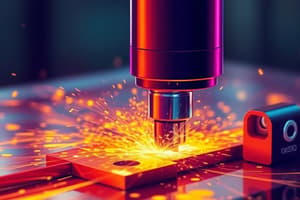Podcast
Questions and Answers
What type of emulsifier is used in Method B?
What type of emulsifier is used in Method B?
- Solvent-based
- Powder-based
- Water-based
- Oil-based (correct)
What is the maximum water pressure used for rinsing after emulsifier application in Method B and D?
What is the maximum water pressure used for rinsing after emulsifier application in Method B and D?
- 20 PSI
- 50 PSI
- 30 PSI
- 40 PSI (correct)
What is the primary method of penetrant removal in Method C?
What is the primary method of penetrant removal in Method C?
- Rinsing with water
- Hand wiping with a solvent-dampened rag (correct)
- Using a dry powder developer
- Applying an emulsifier
What type of inspection is Method C often applied for?
What type of inspection is Method C often applied for?
What is the characteristic of the sensitivity level 1 in non-destructive testing?
What is the characteristic of the sensitivity level 1 in non-destructive testing?
What is the classification of Form a developer in non-destructive testing?
What is the classification of Form a developer in non-destructive testing?
What is the purpose of an emulsifier in the post-emulsifiable method?
What is the purpose of an emulsifier in the post-emulsifiable method?
What is the characteristic of Method C that makes it amendable to portability?
What is the characteristic of Method C that makes it amendable to portability?
What is the classification of Class (1) solvent remover?
What is the classification of Class (1) solvent remover?
What is the common application of Method B and Method D?
What is the common application of Method B and Method D?
Flashcards
Method B emulsifier type
Method B emulsifier type
Oil-based emulsifier is used in Method B for penetrant removal.
Maximum rinsing pressure (Method B/D)
Maximum rinsing pressure (Method B/D)
40 PSI is the maximum water pressure for rinsing after emulsifier application in Methods B and D.
Method C penetrant removal
Method C penetrant removal
Hand wiping with a solvent-dampened rag is the main penetrant removal method in Method C.
Method C inspection
Method C inspection
Signup and view all the flashcards
Sensitivity Level 1 (NDT)
Sensitivity Level 1 (NDT)
Signup and view all the flashcards
Form a developer (NDT)
Form a developer (NDT)
Signup and view all the flashcards
Emulsifier purpose (post-emulsion)
Emulsifier purpose (post-emulsion)
Signup and view all the flashcards
Portability in Method C
Portability in Method C
Signup and view all the flashcards
Class 1 solvent remover type
Class 1 solvent remover type
Signup and view all the flashcards
Common application (Method B/D)
Common application (Method B/D)
Signup and view all the flashcards




